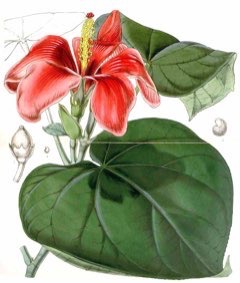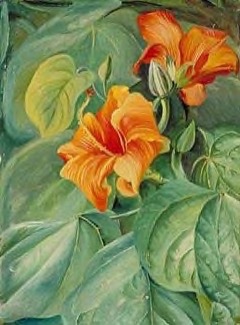 |
|
http://www.edibleplants.org |
 |
| http://www.edibleplants.org |
Translate this page:
Summary
Found in the Caribbean, Blue Tahoe or Talipariti elatum is an evergreen flowering tree growing up to 25 m in height and 45 cm in trunk diameter. It belong in the mallow or Malvaceae family. It is known as the national tree of Jamaica. The trunk is straight, leaves are broad green, and flowers are attractive, changing colors as it matures - from bright yellow to orange red to crimson. No plant part is edible but leaves and young shoots are used in the treatment of dysentery. Inner bark is made into durable ropes and cords. The wood, characterized by blue-green streaks when polished, is moderately heavy but very hard and is used for furniture, carriage and cart work, railway sleepers, etc.
Physical Characteristics

 Talipariti elatum is an evergreen Tree growing to 25 m (82ft) by 25 m (82ft) at a fast rate.
Talipariti elatum is an evergreen Tree growing to 25 m (82ft) by 25 m (82ft) at a fast rate.
See above for USDA hardiness. It is hardy to UK zone 10.
Suitable for: light (sandy), medium (loamy) and heavy (clay) soils and prefers well-drained soil. Suitable pH: mildly acid, neutral and basic (mildly alkaline) soils. It cannot grow in the shade. It prefers dry or moist soil. The plant can tolerates strong winds but not maritime exposure.
UK Hardiness Map
US Hardiness Map
Synonyms
Hibiscus azanzae DC. Hibiscus elatus Sw. Hibiscus tiliaceus elatus (Sw.) Hochr. Pariti grande Britto
Plant Habitats
Edible Uses
References More on Edible Uses
Medicinal Uses
Plants For A Future can not take any responsibility for any adverse effects from the use of plants. Always seek advice from a professional before using a plant medicinally.
Dysentery
An infusion of the mucilaginous leaves and young shoots is used in the treatment of dysentery[342 ].
References More on Medicinal Uses
The Bookshop: Edible Plant Books
Our Latest books on Perennial Plants For Food Forests and Permaculture Gardens in paperback or digital formats.

Edible Tropical Plants
Food Forest Plants for Hotter Conditions: 250+ Plants For Tropical Food Forests & Permaculture Gardens.
More

Edible Temperate Plants
Plants for Your Food Forest: 500 Plants for Temperate Food Forests & Permaculture Gardens.
More

More Books
PFAF have eight books available in paperback and digital formats. Browse the shop for more information.
Shop Now
Other Uses
Fibre Furniture String Wood
Other Uses: The bark is clear in colour, rather soft in texture, and consists of many layers that can be separated after beating. The inner bark is used for making rope and cord, which is reported to be very durable in salt and brackish water[378 ]. The fibres of the bark of young trees make good ropes[342 ]. The lace-like inner bark was at one time known as Cuba bark from its being used as the material for tying round bundles of Havana cigars[342 ]. The heartwood is basically a greyish brown or olive, but is often richly variegated with streaks of purple, metallic blue, and olive, or separated by plain olive patches. The best forms have the appearance, when polished, of dark-green variegated marble[342 , 378 ]. The sapwood is narrow and nearly white. The grain is fairly straight; texture medium to somewhat coarse; surface lustrous; there is no distinctive odour or taste present in seasoned wood[342 , 378 ]. The wood is moderately heavy; very hard, but not so hard as rosewood (Amyris balsamifera); tough; durable to very durable[378 ]. It is very flexible, and is said to have all the characters of the best European ash, but to be more durable and longer in the fibre[342 ]. It works easily, but needs particular care to attain a good polish[378 ]. Wood of good colour is used in cabinet work, for furniture etc, it is much used locally for building purposes, for carriage and cart work and for railway sleepers, it also yields good shingles[342 ]. Use is also made of it for gun-stocks, carriage poles, ships' knees, and fishing rod[46 , 342 ].
Special Uses
References More on Other Uses
Cultivation details
A tree of the lowland tropics. It is not well suited to areas with a mean annual rainfall less than 1,500mm[378 ]. Grows in the wild in a wide range of soils[378 ]. A very wind-resistant species, capable of withstanding hurricanes[307 ]. Trees can flower and produce fruit all year round[714 ].
References Carbon Farming Information and Carbon Sequestration Information
Temperature Converter
Type a value in the Celsius field to convert the value to Fahrenheit:
Fahrenheit:
The PFAF Bookshop
Plants For A Future have a number of books available in paperback and digital form. Book titles include Edible Plants, Edible Perennials, Edible Trees,Edible Shrubs, Woodland Gardening, and Temperate Food Forest Plants. Our new book is Food Forest Plants For Hotter Conditions (Tropical and Sub-Tropical).
Shop Now
Plant Propagation
Seed -
Other Names
If available other names are mentioned here
Native Range
SOUTHERN AMERICA: Cuba, Jamaica
Weed Potential
Right plant wrong place. We are currently updating this section.
Please note that a plant may be invasive in one area but may not in your area so it's worth checking.
Conservation Status
IUCN Red List of Threatened Plants Status : This taxon has not yet been assessed

Growth: S = slow M = medium F = fast. Soil: L = light (sandy) M = medium H = heavy (clay). pH: A = acid N = neutral B = basic (alkaline). Shade: F = full shade S = semi-shade N = no shade. Moisture: D = dry M = Moist We = wet Wa = water.
Now available:
Food Forest Plants for Mediterranean Conditions
350+ Perennial Plants For Mediterranean and Drier Food Forests and Permaculture Gardens.
[Paperback and eBook]
This is the third in Plants For A Future's series of plant guides for food forests tailored to
specific climate zones. Following volumes on temperate and tropical ecosystems, this book focuses
on species suited to Mediterranean conditions—regions with hot, dry summers and cool, wet winters,
often facing the added challenge of climate change.
Read More
Expert comment
Author
(Sw.) Fryxell
Botanical References
Links / References
For a list of references used on this page please go here
A special thanks to Ken Fern for some of the information used on this page.
Readers comment
| Add a comment |
|
If you have important information about this plant that may help other users please add a comment or link below. Only comments or links that are felt to be directly relevant to a plant will be included. If you think a comment/link or information contained on this page is inaccurate or misleading we would welcome your feedback at [email protected]. If you have questions about a plant please use the Forum on this website as we do not have the resources to answer questions ourselves.
* Please note: the comments by website users are not necessarily those held by PFAF and may give misleading or inaccurate information.
To leave a comment please Register or login here All comments need to be approved so will not appear immediately.
|
Subject : Talipariti elatum
|
|
|
|